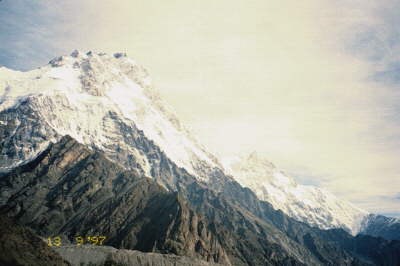
Introduction

The Nanga Parbat Haramosh massif (NPHM) has drawn attention for many reasons: (1) the peak of Nanga Parbat (8123m) sits at the NW terminus of the >2500 km Himalayan arc, away from main locus of high peaks, and represents one of the steepest pieces of topography above the sea (Raikhot Valley: 7 km in 21 km; Rupal Face: 5 km in 2 km); (2) NPHM represents an area of exceedingly young plutonism, metamorphism and cooling (Zeitler, 1985; and, e.g. 1.4 Ma Th-Pb monazite age of Mazeno Pass pluton; Schneider et al., 1997), that occurs within Indian plate crystalline rock that is reworked ~1.8 Ga crust (e.g., Zeitler et al., 1989; Chamberlain et al., 1989; Smith et al., 1992) - a crustal protolith apparently lacking from the main High Himalaya; (3) NPHM has been exhumed from several 10's of km beneath the Kohistan-Ladakh fossil island arc that is trapped between India & Asia in this part of the orogen (Fig. 1); and (4) these young events require exhumation of 5-10 mm/yr (e.g. Craw et al., 1994). In previous reports (e.g. Edwards et al., 1996 - poster at Fall AGU) we have looked at the central and eastern and southern portions of the massif (Fig. 2). Despite the very high rates of exhumation for NPHM, our detailed mapping has revealed no major normal-motion low-angle detachment structure that would allow several kilometres of crustal section to have been completely removed from the NPHM (Upper-Middle Indus River) drainage area. We have, however found some late brittle normal faults that would assist the erosional unroofing (see the companion poster by Seeber et al., displaying data from the Seismic Experiment that is highly consistent with these field observations). We have shown evidence for major shear zones within the massif that have allowed "pop-up" of NPHM as a result of WNW convergence of this part of the Upper Himalaya. For example, the Rupal-Chichi shear zone is an ~ESE-vergent reverse fault, antithetic to the Raikhot fault on the NW side of the massif. In this poster we present some of our data from SW NPHM, showing evidence for the southward continuation of the mechanical system of the Raikhot Fault. It continues as a diffuse, N-S trending, ~W-vergent, reverse sense shear zone that is dominated by a belt of sheared granite/gneiss whose ages (3-12 Ma) are slightly older than those in the very heart of the massif. We attempt to separate early India-Asia collision structures (e.g. the Main Mantle Thrust - MMT) from NPHM pop-up structures, and we discuss possible models for the initial morphology of the MMT.
Forward to: Geology of the southwestern margin of the Nanga Parbat Massif